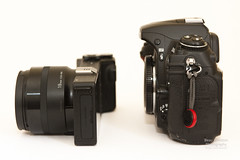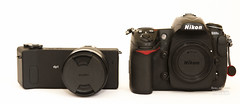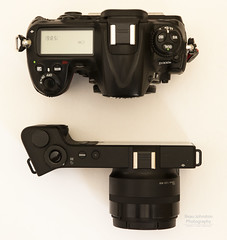Review: Sigma dp1 Quattro
Officially announced February 10, 2014, Sigma Photo's new dp Quattro series of cameras was completely redesigned from its predecessor, the DP Merrill. The design team 'rethought and redesigned every aspect of the camera, including the sensor, engine, lens, and body.' They developed a radically different camera in both form and function.
The dp1 Quattro is unlike any camera I have ever used. Firstly it crams an APC-sized sensor (23.5x15.7mm) into a body the size of most micro-4/3rds cameras. Nikon's soon to be announced D7200 will have a similarly-sized sensor and is expected to have 24M effective pixels, where the dp Quattro's Foveon X3 sensors have 29M effective pixels. Sigma's line of dp Quattro cameras are available in four lens options: dp0 (14mm f4), dp1 (19mm f2.8), dp2 (30mm f2.8), and dp3 (50mm f2.8). We tested the dp1 Quattro over three month's of travel and in a multitude of photography scenarios.
Key Specifications:
- Image Sensor: Foveon X3 Direct Image Sensor (CMOS)
- Image Sensor: Size 23.5x15.7mm
- Effective Pixels: Approx 29MP
- Total Pixels: Approx 33MP
- Storage Media: SD Card, SDHC Card, SDXC Card
- File Format: Lossless compression RAW data (14-bit), JPEG (EXIF2.3), RAW+JPEG
- Focal Length: 19mm (dp1)
- 35mm Equivalent Focal Length: Approx 28mm
- Lens F number: F2.8-16
- Number of Diaphragm Blades: 9 Blades
- Lens Construction: 8 Elements in 6 Groups
- Price: $999.00
First, let's talk about the heart of the dp Quattro line, the Foveon X3 sensor. I am impressed with the detail and color rendering produced by this APC-sized sensor, even in low-light conditions. I really put this to the test when we visited the California Academy of Sciences in San Francisco. The sensor seemed to pull out detail in even the darkest areas and did so without sacrificing detail in the highlights. I am not sure of the actual ratings on the camera's dynamic range, but I am impressed with how the images turned out.
The camera traveled with me to California and Texas, as well as a few local trips here in Wyoming. I was a welcome change from the heft of my D700 and I enjoyed how I could walk around with it all day, hung from my shoulder with my PeakDesign Leash. The controls were easy to access with one hand and the overall layout of the camera was nice and easy to use. I have large hands, and while I could easily reach all of the control buttons, I did find the feel a bit awkward at times. This was not something that my wife complained about, so I chalk it up to having long fingers.
In my early testing, the dp1 seemed to chew through batteries and I soon found myself going to use the camera only to find the battery was dead. The problem, I later discovered was related to how long the screen stayed on before going into standby mode. A few changes in the settings and the dead battery issue was reduced. I also quickly learned to carry both batteries with me, just in case.
 |
| CAS Aquarium: ISO 800, f/2.8, 1/25 sec |
The camera traveled with me to California and Texas, as well as a few local trips here in Wyoming. I was a welcome change from the heft of my D700 and I enjoyed how I could walk around with it all day, hung from my shoulder with my PeakDesign Leash. The controls were easy to access with one hand and the overall layout of the camera was nice and easy to use. I have large hands, and while I could easily reach all of the control buttons, I did find the feel a bit awkward at times. This was not something that my wife complained about, so I chalk it up to having long fingers.
 |
| Sigma dp1 Quattro vs Nikon D300s |
 |
| Sigma dp1 Quattro vs Nikon D300s |
 |
| Sigma dp1 Quattro vs Nikon D300s |
In my early testing, the dp1 seemed to chew through batteries and I soon found myself going to use the camera only to find the battery was dead. The problem, I later discovered was related to how long the screen stayed on before going into standby mode. A few changes in the settings and the dead battery issue was reduced. I also quickly learned to carry both batteries with me, just in case.
 |
| Johnson Space Center: ISO 800, f/16, 1/60 sec |
The dp1 Quattro comes with the 19mm f/2.8 lens permanently attached. While the optics are great, and the lens is a good choice for walking around, I did find myself wanting a tighter crop and less barrel distortion. The downside to the dp Quattro line is the fact they cameras do not have the capability of interchangeable lenses or zoom options. I love prime lenses but I really wish there was an option on these cameras to change out the lenses. I understand adding the ability to incorporate interchangeable lenses would increase the cost, weight, and bulk of the dp line but I think Sigma is loosing out on market share in the mirrorless camera market because of it.
This brings me to my next point, market share and how it affects Sigma. While Sigma's lenses are hugely popular, the company owns less than 1% of the camera market. This translates to Sigma's raw files not being supported by Photoshop Lightroom. Sigma does offer their Photo Pro software as a free download but it adds to the level of work required for post-processing. I will give the folks at Sigma some credit though, their Photo Pro software is easy to use and intuitive; perhaps better than Nikon's View NX but it would have to be. I don't think Nikon really invests any money into maintaining their NX software because of Lightroom but Sigma has to invest in their Photo Pro software because their users do not have any other option. You can open the files in Sigma Photo Pro and batch process them as uncompressed .tiff files before adding them to Lightroom but this adds another few steps to my workflow.
Conclusion:
I really, I mean really, want to recommend the dp Quattro line of cameras to you guys but I know they are not for everyone, and unfortunately, I don't think they are right for me. The Foveon X3 sensor produces beautiful images and the compact size makes it a joy to walk around with. The problem I have is the lack of an interchangeable lens and the lack of support with Lightroom. I would be willing to live with one of the two of these setbacks but the combination of the two makes it difficult for me to see this as a viable tool in my bag.
Disclosure of Material Connection: I was loaned the equipment used in this review in consideration for review publication.
 |
| Cholla Cactus: ISO 100, f/8.0, 1/200 sec Exported directly out of Sigma Photo Pro |
Conclusion:
I really, I mean really, want to recommend the dp Quattro line of cameras to you guys but I know they are not for everyone, and unfortunately, I don't think they are right for me. The Foveon X3 sensor produces beautiful images and the compact size makes it a joy to walk around with. The problem I have is the lack of an interchangeable lens and the lack of support with Lightroom. I would be willing to live with one of the two of these setbacks but the combination of the two makes it difficult for me to see this as a viable tool in my bag.
Disclosure of Material Connection: I was loaned the equipment used in this review in consideration for review publication.
___________________________
If you found this review helpful, please consider using one of the affiliate links below. The price is the same for you, but a small percentage of the purchase price goes to me, which helps keep this site going. Thank you!


